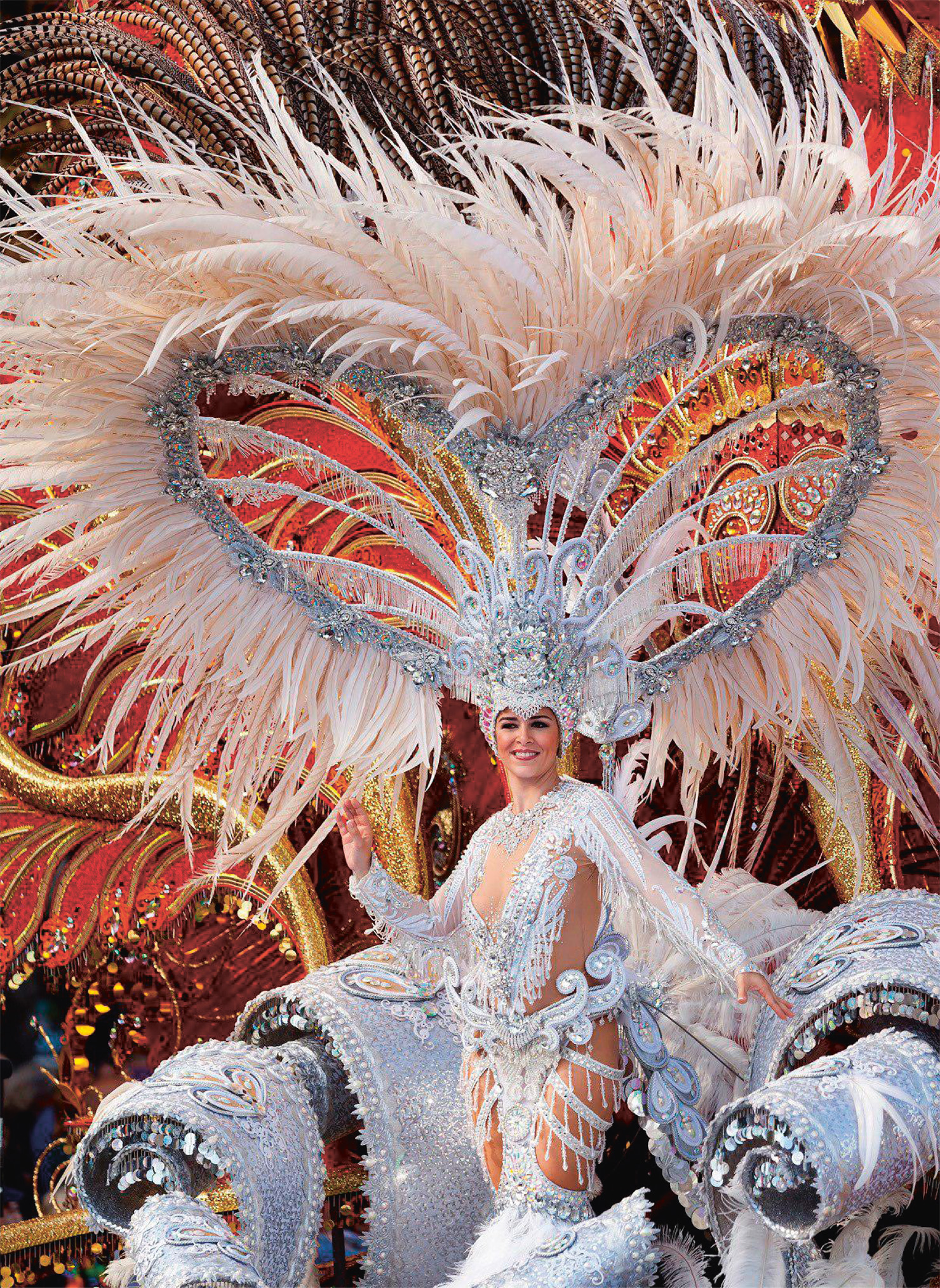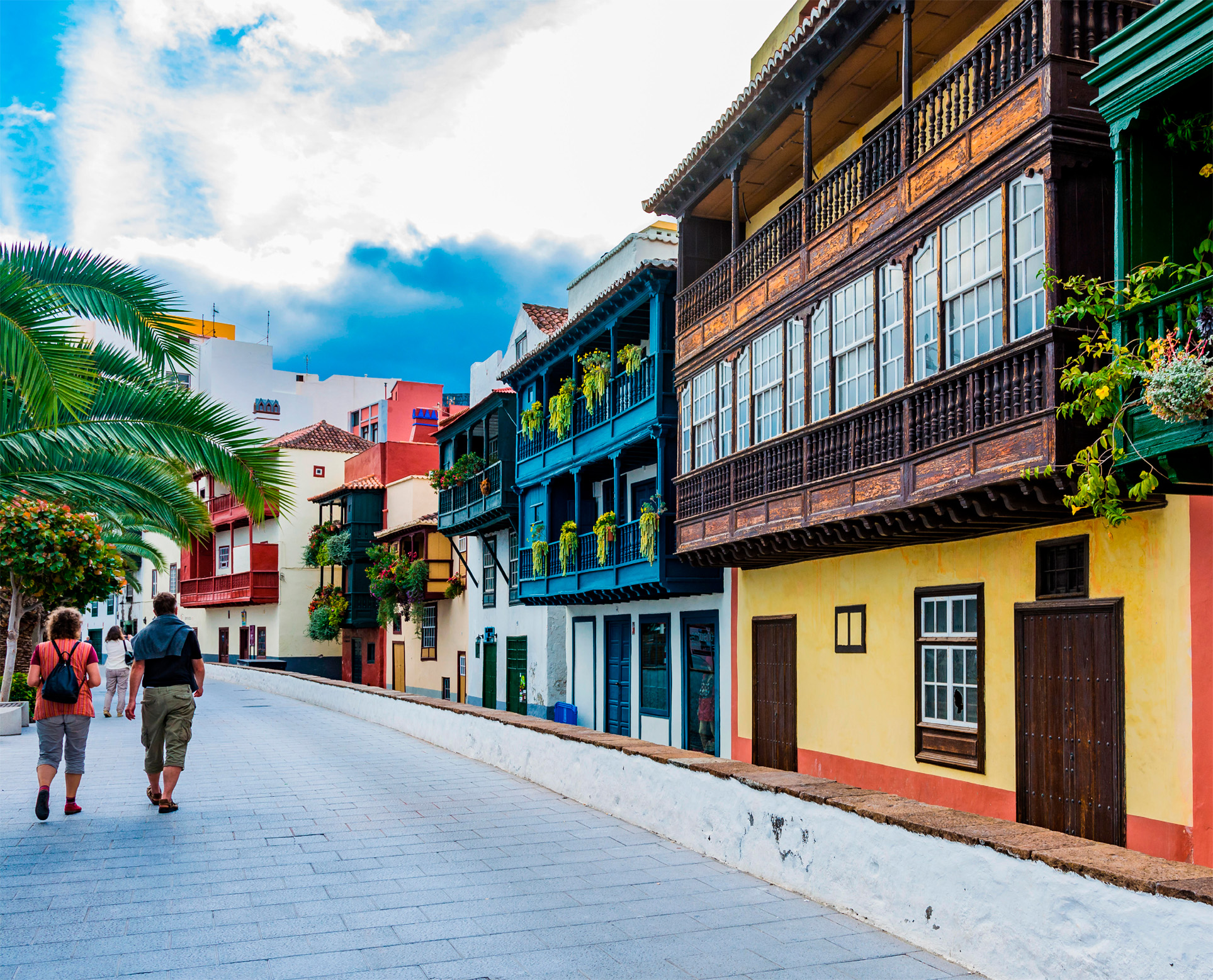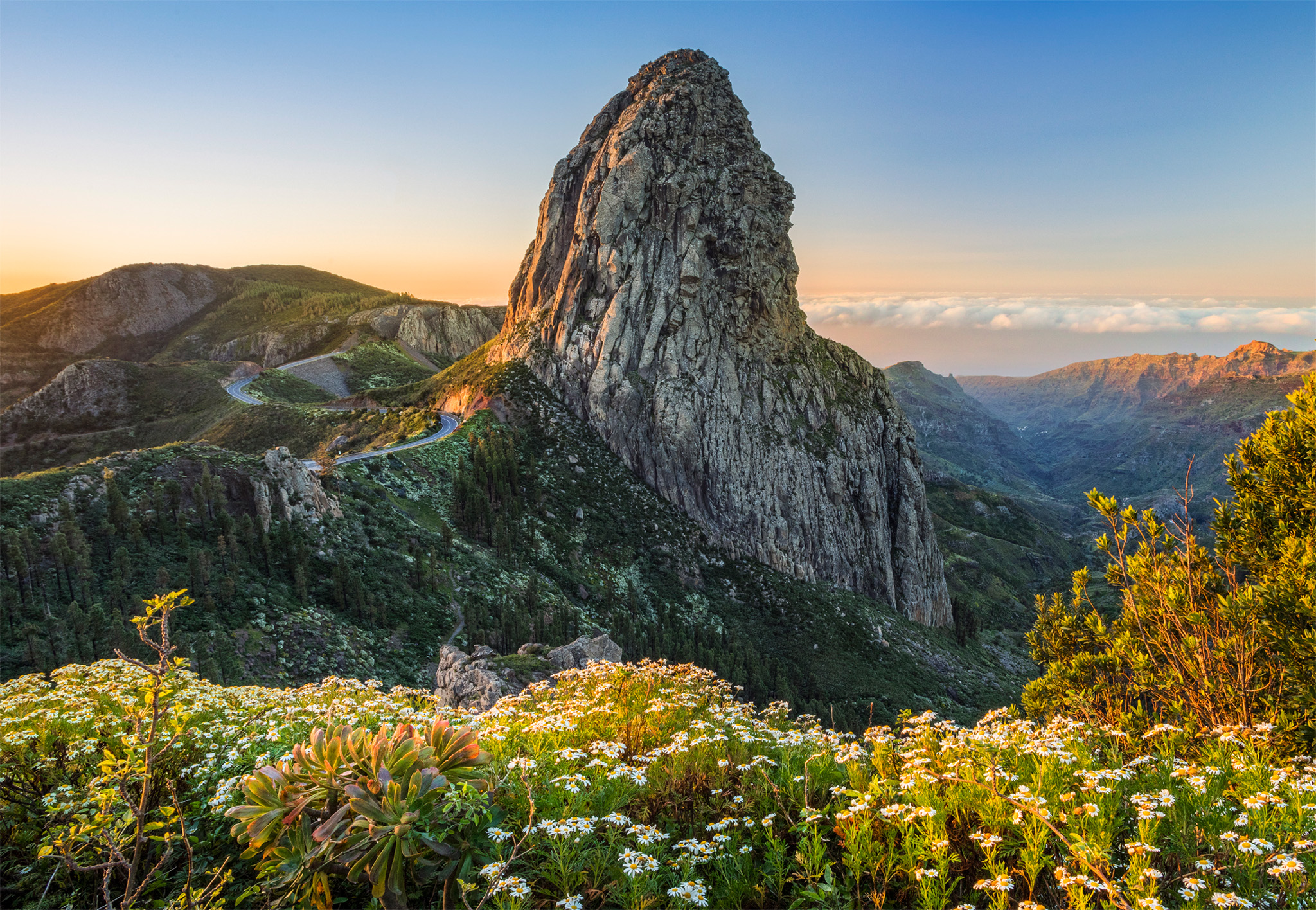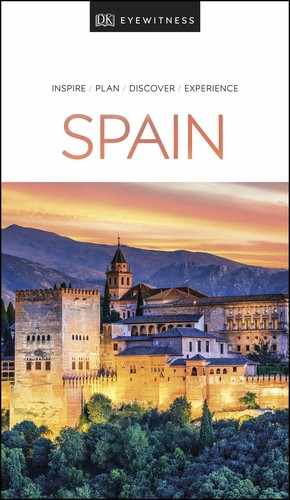Experience More

t A street in La Laguna’s old quarter, a UNESCO World Heritage Site
A bustling university town, La Laguna is the second-largest settlement on Tenerife and a UNESCO World Heritage Site.
Its charming old quarter, which is best explored on foot, has many historic buildings and good museums. Most of the sights lie between the bell-towered Iglesia de Nuestra Señora de la Concepción, which dates from 1502, and the Plaza del Adelantado. The town hall, a convent and the Palacio de Nava stand on this tree-shaded square.
The oldest resort in the Canaries, Puerto de la Cruz first came to prominence in 1706, when a volcanic eruption obliterated Tenerife’s main port of Garachico. Puerto de la Cruz took its place, later becoming popular with genteel English convalescents. The town’s older buildings give it much of its present character.
The beautiful Complejo Costa Martiánez, an open-air swimming complex designed by the famous Lanzarote architect César Manrique, compensates for a lack of good beaches. Lounge or swim in one of its seawater pools, surrounded by palms and fountains.
Outside town, the Jardín de Orquídeas is the oldest garden in Tenerife, and has a large orchid collection. For more nature, Icod de los Vinos, a short drive west, has a spectacular ancient dragon tree.
"
Jardín de Orquídeas
⌂ Camino Sitio Litre s/n # 9:30am–5:30pm daily ∑ jardindeorquideas.com
This coastal town is famous for its shrine to Nuestra Señora de la Candelaria, the Canary Islands’ patron saint, whose image is surrounded by flowers and candles in a modern church in the main square. Supposedly washed ashore in pagan times, this gaudy Virgin was venerated before Christianity reached the island. In 1826 a tidal wave returned her to the sea, but a replica draws pilgrims to worship here every August. Outside, stone effigies of Guanche chiefs line the sea wall.

t Statue of a Guanche chief on the seafront at Candelaria
The old fishing village of Los Cristianos, on Tenerife’s south coast, has grown into a town spreading out along the foot of barren hills. Ferries and hydrofoils make regular trips from its little port to La Gomera and El Hierro.
To the north lies the modern expanse of Playa de las Américas, Tenerife’s largest development. It offers visitors a cheerful, relaxed, undemanding cocktail of sun and fun.
A brief sojourn inland leads to the much older town of Adeje and to the Barranco del Infierno, a wild gorge with an attractive waterfall (2 hours’ round walk from Adeje).
Along the coast to the east, the Costa del Silencio is a pleasant contrast to most of the other large resorts, with its bungalow developments surrounding fishing villages. Los Abrigos has lively fish restaurants lining its harbour.
EXPERIENCE Western Canary Islands
|
Stay Santa Barbara Golf & Ocean Club This four-star resort near Los Cristianos is excellent value for money. ⌂ Avenida del Atlàntico, Golf del Sur, San Miguel de Abona, Tenerife ∑ santabarbaratenerife.com ¡¡¡ |
The rugged mountains north of Santa Cruz are lush, and abound with a range of birds and plants. Walking is popular, and maps showing paths are available from the tourist office. A steep road with marker posts climbs up from the village of San Andrés by the artificial beach of Las Teresitas. On clear days there are splendid vistas along the paths.
Winding down through the laurel forests of Monte de las Mercedes and the valley of Tejina, you will first come to the town of Valle de Guerra, where there is an ethnographic museum. Next, you will reach Tacoronte, with its interesting churches and a bodega.
Nestled in the fertile hills above the Orotava Valley, La Orotava’s historic town clusters around the large Iglesia de Nuestra Señora de la Concepción. This domed Baroque building with twin towers was built in the late 18th century. In the surrounding streets and squares are old churches, convents and grand houses with elaborate wooden balconies. Casa de los Balcones and Casa del Turista, on Calle San Francisco, sell handicrafts and regional food.
Tenerife’s capital city has a deep-water harbour suitable for large ships. Its nicest beach, Las Teresitas, lies 7 km (4 miles) to the north. It was created by importing millions of tonnes of Saharan sand and building a protective reef just offshore. Shaded by palms, this stretch of sand is backed by mountains and is so far devoid of concrete hotel developments.
Santa Cruz boasts many handsome historic buildings. The hub of the city focuses around the Plaza de España, near the harbour. Just off it is the Calle de Castillo, the main shopping street.
Particularly interesting is the Museo de la Naturaleza y el Hombre, in the Palacio Insular, where Guanche mummies grin in glass cases. Other attractions include the Museo de Bellas Artes, featuring old masters. Contemporary sculptures adorn the Parque Municipal García Sanabria, a pleasant park with shady paths.
"
Museo de la Naturaleza y el Hombre
⌂ Calle Fuentes Morales 1 § 922 53 58 16 # 10am–5pm Mon & Sun, 9am–8pm Tue–Sat
Museo de Bellas Artes
⌂ Calle José Murphy 12 § 922 24 43 58 # 10am–8pm Tue–Fri, 10am–3pm Sat & Sun

t Carnival parade through the streets of Santa Cruz de Tenerife

t Pastel faÇades and delicate wooden balconies line the streets of Santa Cruz de la Palma on La Palma
Reaching an altitude of 2,426 m (7,959 ft), La Palma is the world’s steepest island. It lies on the northwestern tip of the archipelago and has a cool, moist climate and lush vegetation. The mountainous interior is covered with forests of pine, laurel and giant fern.
The centre of the island is dominated by the Caldera de Taburiente, a volcano’s massive crater, more than 8 km (5 miles) wide. National park status is an indication of its botanical and geological importance. The International Astrophysics Observatory crowns the summit. A couple of roads traverse La Palma’s dizzy heights, offering fine views of the craters of La Cumbrecita and Roque de los Muchachos.
Santa Cruz de la Palma, the island’s main town and port, is an elegant place of old houses with balconies. In the cobbled street behind the seafront, Calle O’Daly, are the Iglesia El Salvador, boasting a Mudéjar coffered ceiling, and the ayuntamiento, which is housed in a cardinal’s palace. A full-sized cement replica of the Santa María, Columbus’s flagship, stands at the end of the Plaza Alameda.
The tortuous mountain road southwest of Santa Cruz winds over Las Cumbres mountains to El Paso, known for its silk production and hand-rolled cigars.
Due to a lack of sandy beaches, El Hierro has escaped tourist invasions. Instead it has caught the attention of naturalists, with its hilly landscape and unusual fauna and flora. El Hierro is the smallest of the Canaries, and the furthest west.
Valverde, the island’s capital, sits at 600 m (2,000 ft) above sea level. Canary pines and peculiarly twisted juniper trees cover El Hierro’s mountainous interior, best seen from the many footpaths and scenic viewpoints along the roads. A ridge of woodland, curving east–west across the island, marks the edge of a volcano. The crater forms a fertile depression known as El Golfo.
In the far west is the Ermita de los Reyes, a place of pilgrimage and the starting point of the island’s biggest fiesta, held in July every four years.

Great View
Interstellar
A visit to La Palma would not be complete without appreciating the stellar views of one of the world’s clearest night skies. Take a trip with La Palma Astronomy Tours (lapalmastars.com) for insider access to the best spots.
EXPERIENCE Western Canary Islands
|
Eat Enriclai There are only four tables at this unassuming La Palma eatery. With no physical menu, guests are talked through the tasty options by Carmen, the enchanting owner. ⌂ Calle Doctor Santos Abreu 2, Santa Cruz de la Palma, La Palma § 680 20 32 90 ¡¡¡ |

t Rock formation rising above the steep gorges that typify the island of La Gomera
La Gomera is the most accessible of the smaller western islands, only 40 minutes by hydrofoil from Los Cristianos on Tenerife (90 minutes by ferry), or by plane from Tenerife or Gran Canaria. Many come to La Gomera for a day only, taking a coach trip. Others hire a car and explore on their own: a scenic but exhausting drive for a single day as the terrain is intensely buckled, and the central plateau is deeply scored by dramatic ravines. Driving across these gorges involves negotiating countless dizzying hairpin bends.
The best way to enjoy the island is to stay a while and explore it at leisure, preferably doing some walking. On a fine day, La Gomera’s scenery is glorious. Rock pinnacles jut above steep slopes studded with ferns while terraced hillsides glow with palms and flowering creepers. The best section, the Parque Nacional de Garajonay, is a UNESCO World Heritage Site.
San Sebastián, La Gomera’s main town and ferry terminal, is situated on the east coast, a scattering of white buildings around a small beach. Among its sights are some places associated with Columbus, who topped up his water supplies here before setting out on his adventurous voyages. A well in the customs house bears the grand words “With this water America was baptized”. According to legend he also prayed in the Iglesia de la Asunción, and stayed at a local house.
Beyond the arid hills to the south lies Playa de Santiago, the island’s only real resort, which has a grey pebble beach. Valle Gran Rey, in the far west, is a fertile valley of palms and staircase terraces. These days it is colonized by foreigners attempting alternative lifestyles. In the north, tiny roads weave a tortuous course around several pretty villages, plunging at intervals to small, stony beaches. Las Rosas is a popular stop-off for coach parties, who can enjoy the visitors’ centre and a restaurant with a panoramic view.
The road to the coast from Las Rosas leads through the town of Vallehermoso, dwarfed by the huge Roque de Cano, an impressive mass of solidified lava. Just off the north coast is Los Órganos, a fascinating rock formation of crystallized basalt columns resembling the pipes of an organ.
La Gomera’s Whistle Language
The problems of communication posed by La Gomera’s rugged terrain produced an unusual language, known as El Silbo. This system of piercing whistles probably developed because its sounds carry across the great distances from one valley to the next. Its origins are mysterious, but it was allegedly invented by the Guanches. Few young Gomerans have any use for El Silbo today, and the language would probably be dead if it were not for the demonstrations of it still held for visitors at the parador, and in the restaurant at Las Rosas.
